Supply Chain Management Impact on KUDU Restaurant Success in Jordan
VerifiedAdded on 2023/04/25
|64
|15202
|423
Project
AI Summary
This research proposal investigates the impact of supply chain management on the success and failure of the KUDU restaurant chain in Jordan. The study aims to analyze the reasons behind KUDU's operational failure, examining factors such as supply chain structure, supplier relationships, and market dynamics. The proposal includes a detailed literature review covering supply chain management concepts, restaurant performance, and relevant factors. The methodology outlines the research approach, hypothesis development, data collection methods, and ethical considerations. The analysis will incorporate PEST analysis and statistical implications, with the final chapters presenting findings, recommendations, and limitations. The research seeks to provide valuable insights for both scholars and industry practitioners, offering practical strategies for improving supply chain efficiency and enhancing restaurant performance in the Jordanian market.
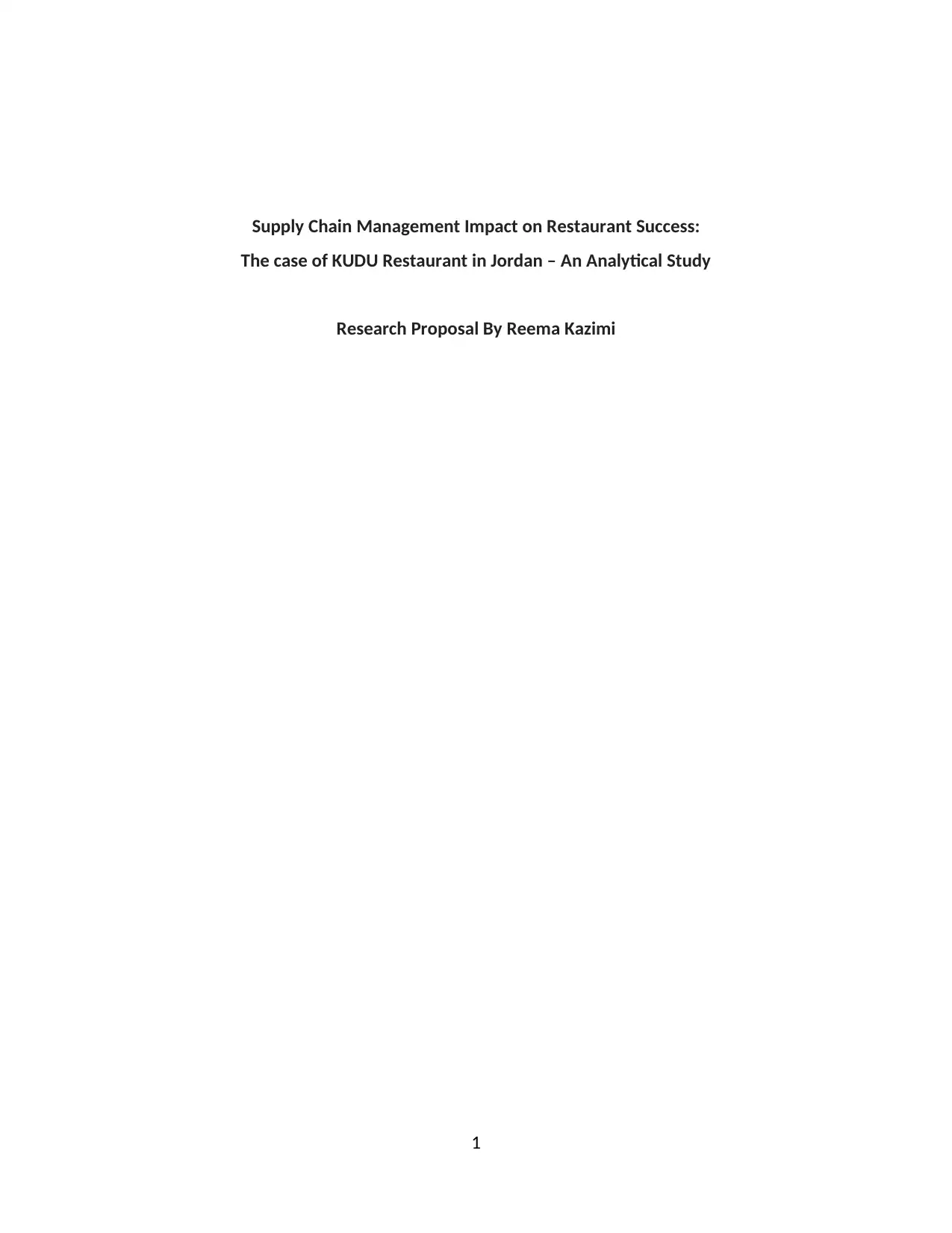
Supply Chain Management Impact on Restaurant Success:
The case of KUDU Restaurant in Jordan – An Analytical Study
Research Proposal By Reema Kazimi
1
The case of KUDU Restaurant in Jordan – An Analytical Study
Research Proposal By Reema Kazimi
1
Paraphrase This Document
Need a fresh take? Get an instant paraphrase of this document with our AI Paraphraser
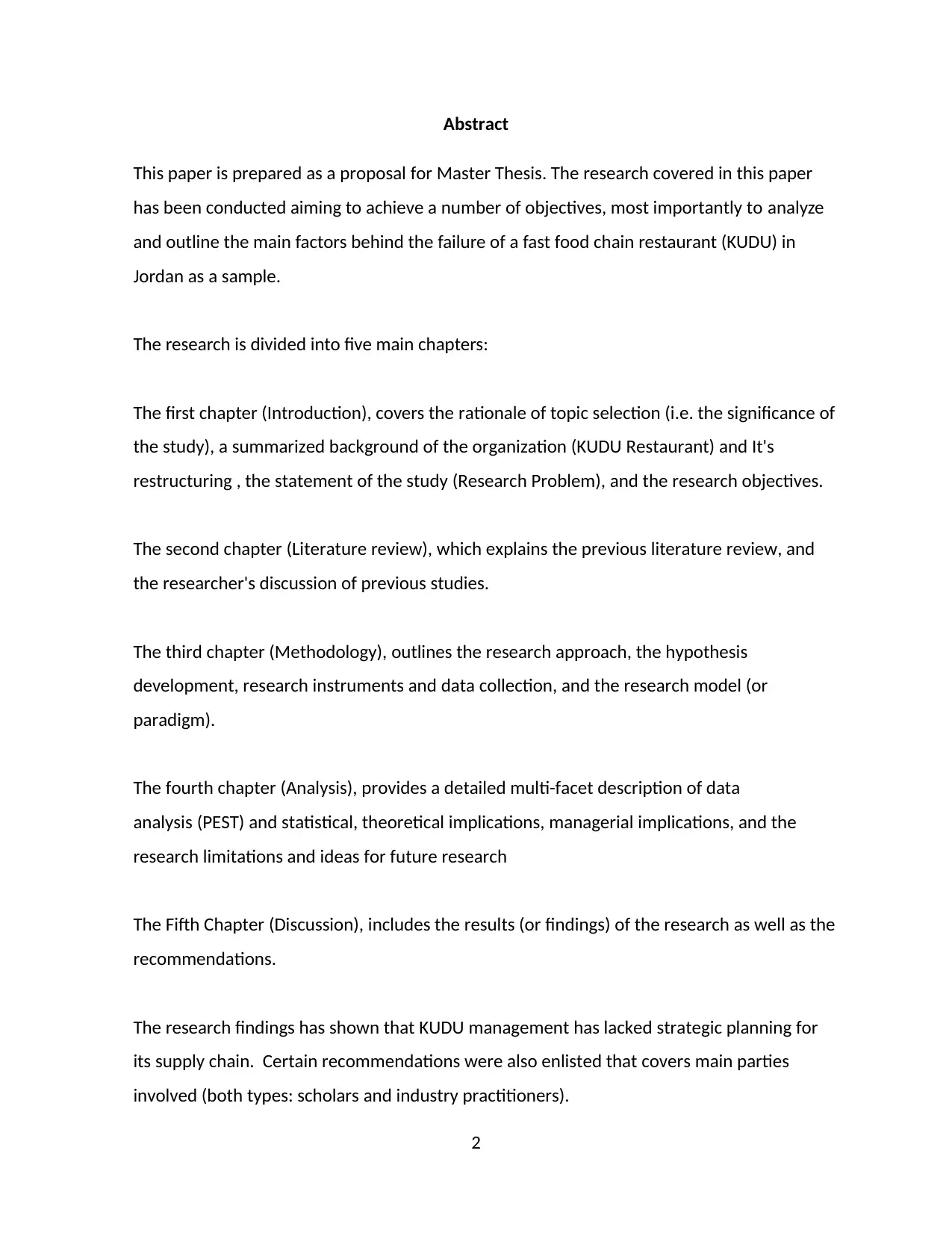
Abstract
This paper is prepared as a proposal for Master Thesis. The research covered in this paper
has been conducted aiming to achieve a number of objectives, most importantly to analyze
and outline the main factors behind the failure of a fast food chain restaurant (KUDU) in
Jordan as a sample.
The research is divided into five main chapters:
The first chapter (Introduction), covers the rationale of topic selection (i.e. the significance of
the study), a summarized background of the organization (KUDU Restaurant) and It's
restructuring , the statement of the study (Research Problem), and the research objectives.
The second chapter (Literature review), which explains the previous literature review, and
the researcher's discussion of previous studies.
The third chapter (Methodology), outlines the research approach, the hypothesis
development, research instruments and data collection, and the research model (or
paradigm).
The fourth chapter (Analysis), provides a detailed multi-facet description of data
analysis (PEST) and statistical, theoretical implications, managerial implications, and the
research limitations and ideas for future research
The Fifth Chapter (Discussion), includes the results (or findings) of the research as well as the
recommendations.
The research findings has shown that KUDU management has lacked strategic planning for
its supply chain. Certain recommendations were also enlisted that covers main parties
involved (both types: scholars and industry practitioners).
2
This paper is prepared as a proposal for Master Thesis. The research covered in this paper
has been conducted aiming to achieve a number of objectives, most importantly to analyze
and outline the main factors behind the failure of a fast food chain restaurant (KUDU) in
Jordan as a sample.
The research is divided into five main chapters:
The first chapter (Introduction), covers the rationale of topic selection (i.e. the significance of
the study), a summarized background of the organization (KUDU Restaurant) and It's
restructuring , the statement of the study (Research Problem), and the research objectives.
The second chapter (Literature review), which explains the previous literature review, and
the researcher's discussion of previous studies.
The third chapter (Methodology), outlines the research approach, the hypothesis
development, research instruments and data collection, and the research model (or
paradigm).
The fourth chapter (Analysis), provides a detailed multi-facet description of data
analysis (PEST) and statistical, theoretical implications, managerial implications, and the
research limitations and ideas for future research
The Fifth Chapter (Discussion), includes the results (or findings) of the research as well as the
recommendations.
The research findings has shown that KUDU management has lacked strategic planning for
its supply chain. Certain recommendations were also enlisted that covers main parties
involved (both types: scholars and industry practitioners).
2

3
⊘ This is a preview!⊘
Do you want full access?
Subscribe today to unlock all pages.

Trusted by 1+ million students worldwide
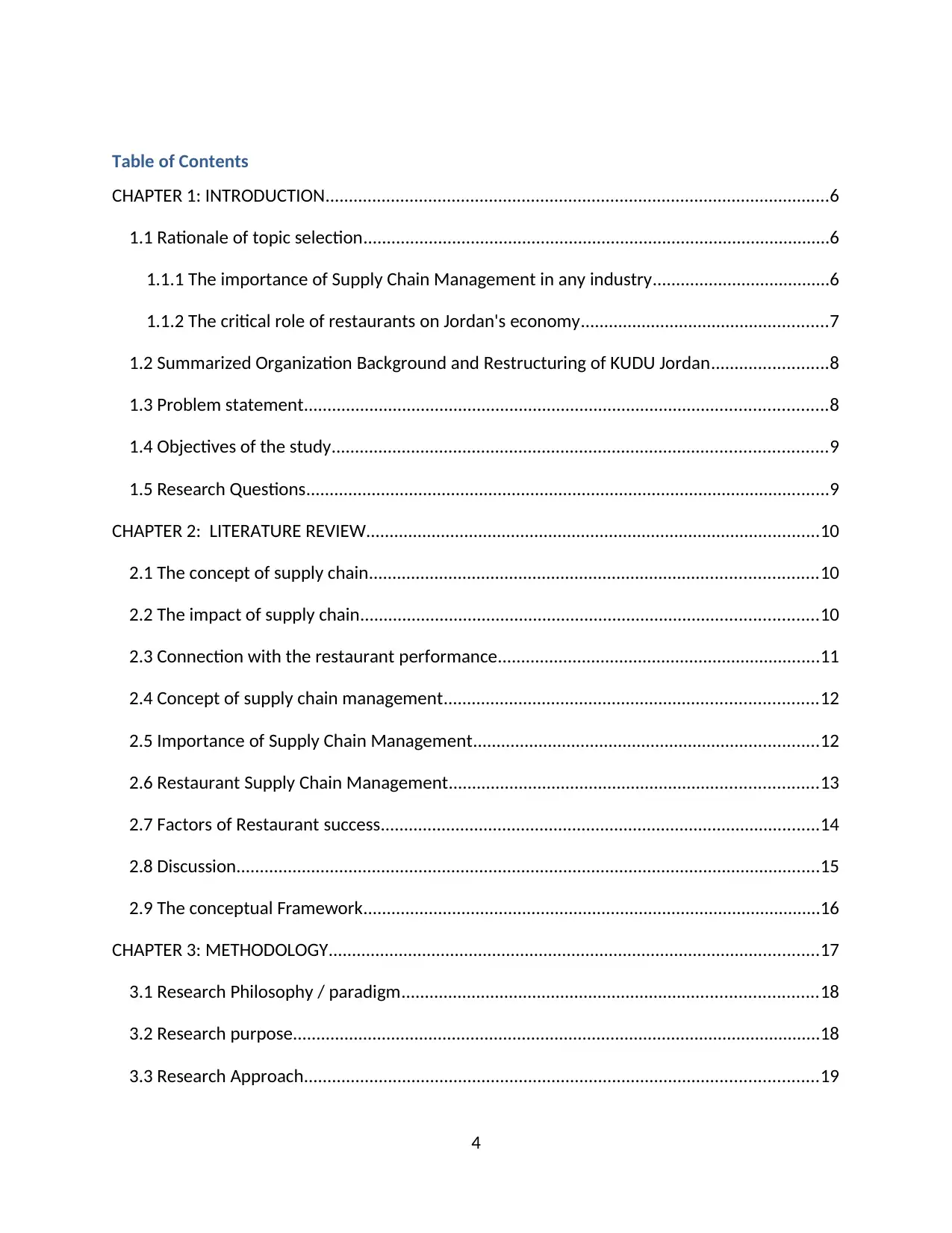
Table of Contents
CHAPTER 1: INTRODUCTION............................................................................................................6
1.1 Rationale of topic selection....................................................................................................6
1.1.1 The importance of Supply Chain Management in any industry......................................6
1.1.2 The critical role of restaurants on Jordan's economy.....................................................7
1.2 Summarized Organization Background and Restructuring of KUDU Jordan.........................8
1.3 Problem statement................................................................................................................8
1.4 Objectives of the study..........................................................................................................9
1.5 Research Questions................................................................................................................9
CHAPTER 2: LITERATURE REVIEW.................................................................................................10
2.1 The concept of supply chain................................................................................................10
2.2 The impact of supply chain..................................................................................................10
2.3 Connection with the restaurant performance.....................................................................11
2.4 Concept of supply chain management................................................................................12
2.5 Importance of Supply Chain Management..........................................................................12
2.6 Restaurant Supply Chain Management...............................................................................13
2.7 Factors of Restaurant success..............................................................................................14
2.8 Discussion.............................................................................................................................15
2.9 The conceptual Framework..................................................................................................16
CHAPTER 3: METHODOLOGY.........................................................................................................17
3.1 Research Philosophy / paradigm.........................................................................................18
3.2 Research purpose.................................................................................................................18
3.3 Research Approach..............................................................................................................19
4
CHAPTER 1: INTRODUCTION............................................................................................................6
1.1 Rationale of topic selection....................................................................................................6
1.1.1 The importance of Supply Chain Management in any industry......................................6
1.1.2 The critical role of restaurants on Jordan's economy.....................................................7
1.2 Summarized Organization Background and Restructuring of KUDU Jordan.........................8
1.3 Problem statement................................................................................................................8
1.4 Objectives of the study..........................................................................................................9
1.5 Research Questions................................................................................................................9
CHAPTER 2: LITERATURE REVIEW.................................................................................................10
2.1 The concept of supply chain................................................................................................10
2.2 The impact of supply chain..................................................................................................10
2.3 Connection with the restaurant performance.....................................................................11
2.4 Concept of supply chain management................................................................................12
2.5 Importance of Supply Chain Management..........................................................................12
2.6 Restaurant Supply Chain Management...............................................................................13
2.7 Factors of Restaurant success..............................................................................................14
2.8 Discussion.............................................................................................................................15
2.9 The conceptual Framework..................................................................................................16
CHAPTER 3: METHODOLOGY.........................................................................................................17
3.1 Research Philosophy / paradigm.........................................................................................18
3.2 Research purpose.................................................................................................................18
3.3 Research Approach..............................................................................................................19
4
Paraphrase This Document
Need a fresh take? Get an instant paraphrase of this document with our AI Paraphraser
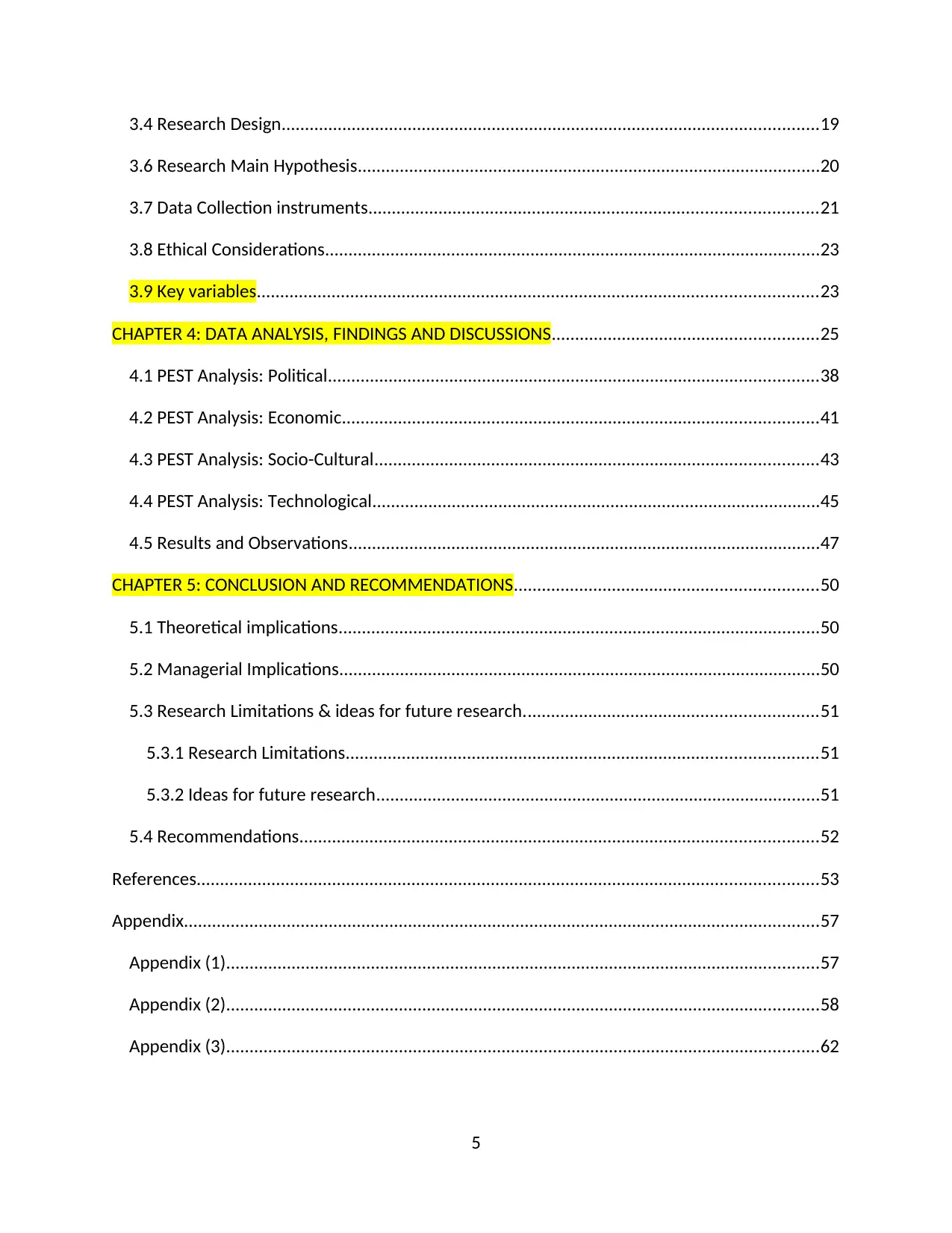
3.4 Research Design...................................................................................................................19
3.6 Research Main Hypothesis...................................................................................................20
3.7 Data Collection instruments................................................................................................21
3.8 Ethical Considerations..........................................................................................................23
3.9 Key variables........................................................................................................................23
CHAPTER 4: DATA ANALYSIS, FINDINGS AND DISCUSSIONS.........................................................25
4.1 PEST Analysis: Political.........................................................................................................38
4.2 PEST Analysis: Economic......................................................................................................41
4.3 PEST Analysis: Socio-Cultural...............................................................................................43
4.4 PEST Analysis: Technological................................................................................................45
4.5 Results and Observations.....................................................................................................47
CHAPTER 5: CONCLUSION AND RECOMMENDATIONS.................................................................50
5.1 Theoretical implications.......................................................................................................50
5.2 Managerial Implications.......................................................................................................50
5.3 Research Limitations & ideas for future research...............................................................51
5.3.1 Research Limitations.....................................................................................................51
5.3.2 Ideas for future research...............................................................................................51
5.4 Recommendations...............................................................................................................52
References.....................................................................................................................................53
Appendix........................................................................................................................................57
Appendix (1)...............................................................................................................................57
Appendix (2)...............................................................................................................................58
Appendix (3)...............................................................................................................................62
5
3.6 Research Main Hypothesis...................................................................................................20
3.7 Data Collection instruments................................................................................................21
3.8 Ethical Considerations..........................................................................................................23
3.9 Key variables........................................................................................................................23
CHAPTER 4: DATA ANALYSIS, FINDINGS AND DISCUSSIONS.........................................................25
4.1 PEST Analysis: Political.........................................................................................................38
4.2 PEST Analysis: Economic......................................................................................................41
4.3 PEST Analysis: Socio-Cultural...............................................................................................43
4.4 PEST Analysis: Technological................................................................................................45
4.5 Results and Observations.....................................................................................................47
CHAPTER 5: CONCLUSION AND RECOMMENDATIONS.................................................................50
5.1 Theoretical implications.......................................................................................................50
5.2 Managerial Implications.......................................................................................................50
5.3 Research Limitations & ideas for future research...............................................................51
5.3.1 Research Limitations.....................................................................................................51
5.3.2 Ideas for future research...............................................................................................51
5.4 Recommendations...............................................................................................................52
References.....................................................................................................................................53
Appendix........................................................................................................................................57
Appendix (1)...............................................................................................................................57
Appendix (2)...............................................................................................................................58
Appendix (3)...............................................................................................................................62
5

6
⊘ This is a preview!⊘
Do you want full access?
Subscribe today to unlock all pages.

Trusted by 1+ million students worldwide

CHAPTER 1: INTRODUCTION
1.1 Rationale of topic selection
1.1.1 The importance of Supply Chain Management in any industry
Supply Chain Management (SCM) in organizations is a critical issue which attracted a
considerable attention and is the topic of a big debate by scholars as well as industry
practitioners in the last two decades. As a new phenomenon (Wisner et al, 2008) an Integrated
supply chain management has its benefits and problems. Benefits are clearly linked to building
trust between supply chain members, more accurate assessment of the deficiencies or the
realignment of the competitive strategies employed among firms. On the other hand, supply
chain management drawbacks may include its costs, sophistication and time consumption. The
supply chain management of a restaurant consists of many parts. The parts are the purchasing
order management, the vendor management, stock management, consumption and variance
management. The supply chain management can have huge impact on a restaurant business as
per the views of Ciani, Vörös and Fagioli (2016). Taken for example, the traditional supply chain
technology can put the profits of a restaurant at risk. It has been found that the restaurant
companies are using such technologies which do not suit to the running of a complex supply
chain. Running these systems is a growing challenge for the restaurants. According to
Bendeković, Jadranka et al. (2016), the supply chain has to be associated with the enterprise
and across all the partners of the supply chain. On the other hand, the restaurant supply chain
management with the use of spreadsheets, various electronic systems along with the paper
invoices can create staggering monetary loses and still remain invisible. Hence, without an
integrated system, the complexity of managing the supply chain increases upto greater extent.
Although it is time-consuming and costly, but delayed, inefficient and poorly constructed supply
chain can highly affect the business.
This particular research will focus on the importance of supply chain management in
the success of a restaurant. A supply chain consists of the inventory management that is huge
7
1.1 Rationale of topic selection
1.1.1 The importance of Supply Chain Management in any industry
Supply Chain Management (SCM) in organizations is a critical issue which attracted a
considerable attention and is the topic of a big debate by scholars as well as industry
practitioners in the last two decades. As a new phenomenon (Wisner et al, 2008) an Integrated
supply chain management has its benefits and problems. Benefits are clearly linked to building
trust between supply chain members, more accurate assessment of the deficiencies or the
realignment of the competitive strategies employed among firms. On the other hand, supply
chain management drawbacks may include its costs, sophistication and time consumption. The
supply chain management of a restaurant consists of many parts. The parts are the purchasing
order management, the vendor management, stock management, consumption and variance
management. The supply chain management can have huge impact on a restaurant business as
per the views of Ciani, Vörös and Fagioli (2016). Taken for example, the traditional supply chain
technology can put the profits of a restaurant at risk. It has been found that the restaurant
companies are using such technologies which do not suit to the running of a complex supply
chain. Running these systems is a growing challenge for the restaurants. According to
Bendeković, Jadranka et al. (2016), the supply chain has to be associated with the enterprise
and across all the partners of the supply chain. On the other hand, the restaurant supply chain
management with the use of spreadsheets, various electronic systems along with the paper
invoices can create staggering monetary loses and still remain invisible. Hence, without an
integrated system, the complexity of managing the supply chain increases upto greater extent.
Although it is time-consuming and costly, but delayed, inefficient and poorly constructed supply
chain can highly affect the business.
This particular research will focus on the importance of supply chain management in
the success of a restaurant. A supply chain consists of the inventory management that is huge
7
Paraphrase This Document
Need a fresh take? Get an instant paraphrase of this document with our AI Paraphraser

part in the success of an organization. The paper will draw inference from theories and models
from the scholarly articles to support the research statements. The research statement of the
problem will justify the reason behind conducting the research on this particular topic. The
fulfillment of the customer demand is necessary and at the same time, the waste reduction and
lowering of the overhead costs are also necessary. A proper network is required for the
completion of end–to-end visibility, collaboration and the business intelligence (Mung’onye,
Paul 2008). One such example is the Real Time Value Network that helps to share the real-time
demand along with the information with instant visibility and the automated actions. It also
eliminates the delays and at the same time reduces the costs by the reduction of waste
materials. On the contrary, according to Teddlie and Tashakkori (2009), the supply chain of the
restaurants can be managed by on–time pricing delivery, speed control and adherence on the
service level comments. (Appendix #3)
Thus, the problem statement for this study is that an efficient supply chain
management is an essential factor of success for any industry, including the restaurant industry.
However, to achieve efficiency of supply chain management in the restaurant industry, there are
many factors that need to be addressed in an in-depth manner to get an overview of the
challenges. This study will investigate and evaluate the success and the challenging factors that
affect the efficiency of the supply chain management of the restaurants, which in turn affect the
performance as well as success of the restaurants.
1.1.2 The critical role of restaurants on Jordan's economy
The restaurant industry in Jordan plays a significant role in the growth of its economy, although
it heavily depends on the tourist inflow to the country. In 2016, there are more than 900
restaurants in Jordan, among which 85% are located in Amman (Mustafa 2016). It has been
found that the restaurants located outside Amman faced a 20 to 30% drop in the revenues due
to lack of tourists and adequate capital while the restaurants in Amman have been growing.
However, in 2017, drop in the number tourists have led to a drop of 10-30% of the revenue in
the restaurant industry of Jordan (Mustafa 2017). Due to its strategic importance for the
sustainability of organizations in general and for restaurants in particular, supply chain
8
from the scholarly articles to support the research statements. The research statement of the
problem will justify the reason behind conducting the research on this particular topic. The
fulfillment of the customer demand is necessary and at the same time, the waste reduction and
lowering of the overhead costs are also necessary. A proper network is required for the
completion of end–to-end visibility, collaboration and the business intelligence (Mung’onye,
Paul 2008). One such example is the Real Time Value Network that helps to share the real-time
demand along with the information with instant visibility and the automated actions. It also
eliminates the delays and at the same time reduces the costs by the reduction of waste
materials. On the contrary, according to Teddlie and Tashakkori (2009), the supply chain of the
restaurants can be managed by on–time pricing delivery, speed control and adherence on the
service level comments. (Appendix #3)
Thus, the problem statement for this study is that an efficient supply chain
management is an essential factor of success for any industry, including the restaurant industry.
However, to achieve efficiency of supply chain management in the restaurant industry, there are
many factors that need to be addressed in an in-depth manner to get an overview of the
challenges. This study will investigate and evaluate the success and the challenging factors that
affect the efficiency of the supply chain management of the restaurants, which in turn affect the
performance as well as success of the restaurants.
1.1.2 The critical role of restaurants on Jordan's economy
The restaurant industry in Jordan plays a significant role in the growth of its economy, although
it heavily depends on the tourist inflow to the country. In 2016, there are more than 900
restaurants in Jordan, among which 85% are located in Amman (Mustafa 2016). It has been
found that the restaurants located outside Amman faced a 20 to 30% drop in the revenues due
to lack of tourists and adequate capital while the restaurants in Amman have been growing.
However, in 2017, drop in the number tourists have led to a drop of 10-30% of the revenue in
the restaurant industry of Jordan (Mustafa 2017). Due to its strategic importance for the
sustainability of organizations in general and for restaurants in particular, supply chain
8
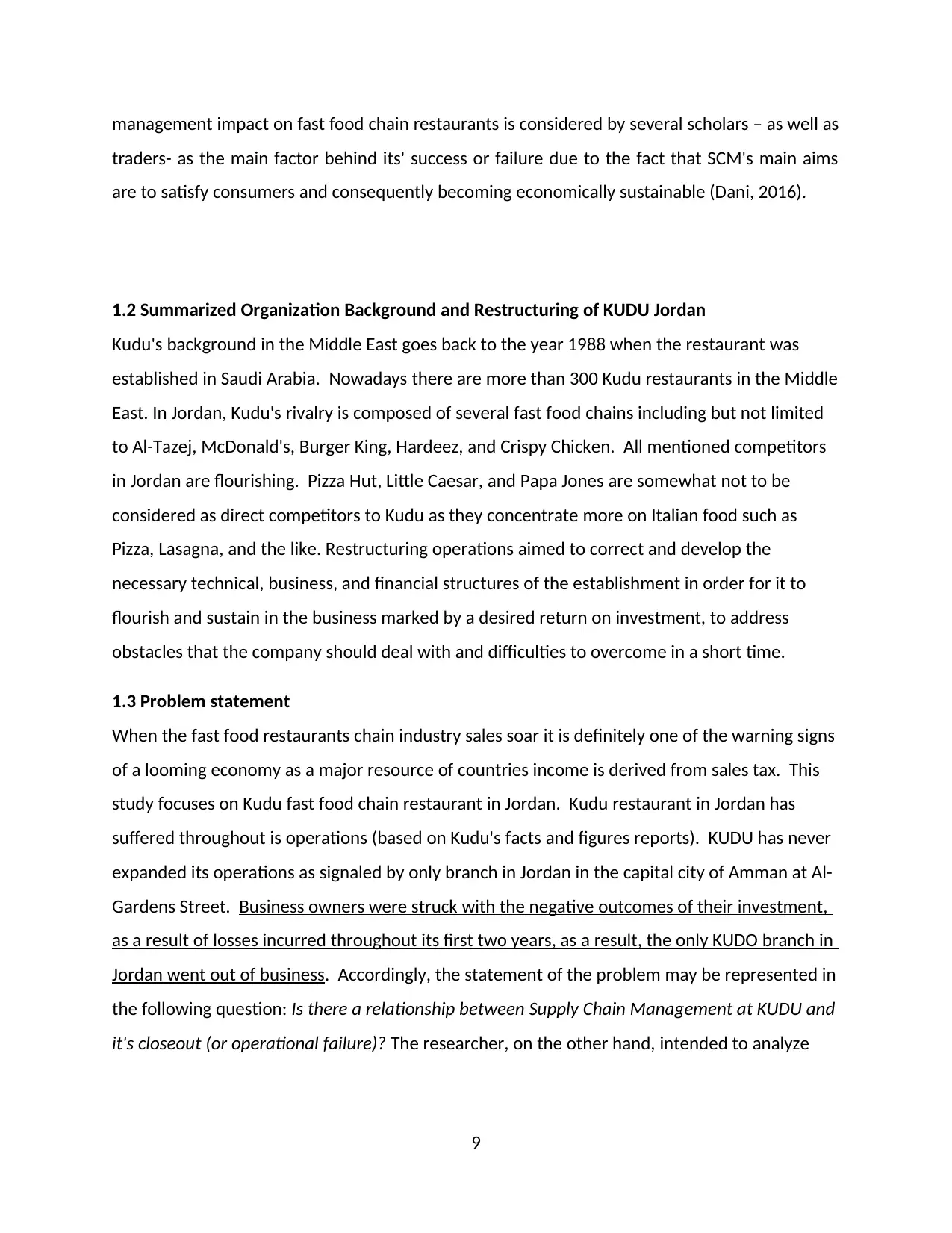
management impact on fast food chain restaurants is considered by several scholars – as well as
traders- as the main factor behind its' success or failure due to the fact that SCM's main aims
are to satisfy consumers and consequently becoming economically sustainable (Dani, 2016).
1.2 Summarized Organization Background and Restructuring of KUDU Jordan
Kudu's background in the Middle East goes back to the year 1988 when the restaurant was
established in Saudi Arabia. Nowadays there are more than 300 Kudu restaurants in the Middle
East. In Jordan, Kudu's rivalry is composed of several fast food chains including but not limited
to Al-Tazej, McDonald's, Burger King, Hardeez, and Crispy Chicken. All mentioned competitors
in Jordan are flourishing. Pizza Hut, Little Caesar, and Papa Jones are somewhat not to be
considered as direct competitors to Kudu as they concentrate more on Italian food such as
Pizza, Lasagna, and the like. Restructuring operations aimed to correct and develop the
necessary technical, business, and financial structures of the establishment in order for it to
flourish and sustain in the business marked by a desired return on investment, to address
obstacles that the company should deal with and difficulties to overcome in a short time.
1.3 Problem statement
When the fast food restaurants chain industry sales soar it is definitely one of the warning signs
of a looming economy as a major resource of countries income is derived from sales tax. This
study focuses on Kudu fast food chain restaurant in Jordan. Kudu restaurant in Jordan has
suffered throughout is operations (based on Kudu's facts and figures reports). KUDU has never
expanded its operations as signaled by only branch in Jordan in the capital city of Amman at Al-
Gardens Street. Business owners were struck with the negative outcomes of their investment,
as a result of losses incurred throughout its first two years, as a result, the only KUDO branch in
Jordan went out of business. Accordingly, the statement of the problem may be represented in
the following question: Is there a relationship between Supply Chain Management at KUDU and
it's closeout (or operational failure)? The researcher, on the other hand, intended to analyze
9
traders- as the main factor behind its' success or failure due to the fact that SCM's main aims
are to satisfy consumers and consequently becoming economically sustainable (Dani, 2016).
1.2 Summarized Organization Background and Restructuring of KUDU Jordan
Kudu's background in the Middle East goes back to the year 1988 when the restaurant was
established in Saudi Arabia. Nowadays there are more than 300 Kudu restaurants in the Middle
East. In Jordan, Kudu's rivalry is composed of several fast food chains including but not limited
to Al-Tazej, McDonald's, Burger King, Hardeez, and Crispy Chicken. All mentioned competitors
in Jordan are flourishing. Pizza Hut, Little Caesar, and Papa Jones are somewhat not to be
considered as direct competitors to Kudu as they concentrate more on Italian food such as
Pizza, Lasagna, and the like. Restructuring operations aimed to correct and develop the
necessary technical, business, and financial structures of the establishment in order for it to
flourish and sustain in the business marked by a desired return on investment, to address
obstacles that the company should deal with and difficulties to overcome in a short time.
1.3 Problem statement
When the fast food restaurants chain industry sales soar it is definitely one of the warning signs
of a looming economy as a major resource of countries income is derived from sales tax. This
study focuses on Kudu fast food chain restaurant in Jordan. Kudu restaurant in Jordan has
suffered throughout is operations (based on Kudu's facts and figures reports). KUDU has never
expanded its operations as signaled by only branch in Jordan in the capital city of Amman at Al-
Gardens Street. Business owners were struck with the negative outcomes of their investment,
as a result of losses incurred throughout its first two years, as a result, the only KUDO branch in
Jordan went out of business. Accordingly, the statement of the problem may be represented in
the following question: Is there a relationship between Supply Chain Management at KUDU and
it's closeout (or operational failure)? The researcher, on the other hand, intended to analyze
9
⊘ This is a preview!⊘
Do you want full access?
Subscribe today to unlock all pages.

Trusted by 1+ million students worldwide

this case from the prospective of Supply Chain Management, as it is described earlier as one of
the most crucial factors of business success.
This research is in-fact divided into two parts: The first part, which is related to a past situation,
analyzes the main reasons behind the failure of KUDO fast-food chain restaurant in Jordan. The
second part outlines present practices applied by successful fast-food restaurants, in order to
suggest operational means and ways for improving the prospects of new entrants to this
industry.
1.4 Objectives of the study
This study aims at the following:
1) To describe the structure/status of the subject restaurant supply chain elements; such
elements include suppliers, distributers, customers, and the company.
2) To analyze and outline the main factors behind the failure of a fast food chain restaurant
(KUDU) in Jordan as a sample; and what measures – if taken- would've increased its sales and
consequently increased its customer loyalty. This would've prevented the restaurant from
undertaking losses and which resulted in its closeout.
3) To monitor and report current practices by successful supply chain food restaurants in
Amman, the Capital city of Jordan.
1.5 Research Questions
Q.1: How supply chain process helps in achieving success in the Restaurants?
Q.2: How to monitor and report the current practices by the successful supply chain food
restaurants in Amman, the city of Jordan?
Q. 3: How are the supply chain elements such as distributers, the suppliers, customers and the
company are interlinked with each other?
10
the most crucial factors of business success.
This research is in-fact divided into two parts: The first part, which is related to a past situation,
analyzes the main reasons behind the failure of KUDO fast-food chain restaurant in Jordan. The
second part outlines present practices applied by successful fast-food restaurants, in order to
suggest operational means and ways for improving the prospects of new entrants to this
industry.
1.4 Objectives of the study
This study aims at the following:
1) To describe the structure/status of the subject restaurant supply chain elements; such
elements include suppliers, distributers, customers, and the company.
2) To analyze and outline the main factors behind the failure of a fast food chain restaurant
(KUDU) in Jordan as a sample; and what measures – if taken- would've increased its sales and
consequently increased its customer loyalty. This would've prevented the restaurant from
undertaking losses and which resulted in its closeout.
3) To monitor and report current practices by successful supply chain food restaurants in
Amman, the Capital city of Jordan.
1.5 Research Questions
Q.1: How supply chain process helps in achieving success in the Restaurants?
Q.2: How to monitor and report the current practices by the successful supply chain food
restaurants in Amman, the city of Jordan?
Q. 3: How are the supply chain elements such as distributers, the suppliers, customers and the
company are interlinked with each other?
10
Paraphrase This Document
Need a fresh take? Get an instant paraphrase of this document with our AI Paraphraser

CHAPTER 2: LITERATURE REVIEW
2.1 The concept of supply chain
Many scholars have addressed the definition of supply chain management, and although these
definitions differ (Muysinaliyev and Aktamov, 2014). Supply chain management was defined by
some scholars as the management of the upstream and the downstream value-added flows of
the materials, the final goods and also various related information among the resellers, the
suppliers, the company and the final customers (Kotler and Armstrong, 2006, 379). Other
scholars, has defined it as a designed operation and also the improvement that creates and also
delivers the primary products, services of the company (Jacobs and Chase, 2011, 4). Another
definition was brought by Diaconu and Alpopi. They suggested that it is a potential way for
securing the competitive advantage and also improving the organizational performance. It is
because the competition is not anymore between the companies but the supply chains. They
also argued that they are the key improvement areas for example, the strategic orientation, the
IT support and the process, the organization and the management, the measurement and the
cooperation, which are outlined and evaluated by at various levels, that can bring improvement
in the SCM process and performance (Diaconu and Alpopi, 2014, 3).
Christopher (2016, 8) defined Supply Chain Management (SCM) as a philosophy of management
that involves the integration of a set of selected key business processes from end user through
original suppliers.
2.2 The impact of supply chain
Supply Chain Management has played a critical role in the survival, continuity and success of
companies or business organizations. On the other hand, there were other concerns when it
comes to supply chain in relation to environment (i.e. ecology) as well as the economy as they
both impact sustainability of the organizations (Karen, 2012). A sustainable system will have the
economy as their basis for better environment for the future and current generations along with
the ecological and regenerative market capacity. Restaurants can control flows of energy, food
11
2.1 The concept of supply chain
Many scholars have addressed the definition of supply chain management, and although these
definitions differ (Muysinaliyev and Aktamov, 2014). Supply chain management was defined by
some scholars as the management of the upstream and the downstream value-added flows of
the materials, the final goods and also various related information among the resellers, the
suppliers, the company and the final customers (Kotler and Armstrong, 2006, 379). Other
scholars, has defined it as a designed operation and also the improvement that creates and also
delivers the primary products, services of the company (Jacobs and Chase, 2011, 4). Another
definition was brought by Diaconu and Alpopi. They suggested that it is a potential way for
securing the competitive advantage and also improving the organizational performance. It is
because the competition is not anymore between the companies but the supply chains. They
also argued that they are the key improvement areas for example, the strategic orientation, the
IT support and the process, the organization and the management, the measurement and the
cooperation, which are outlined and evaluated by at various levels, that can bring improvement
in the SCM process and performance (Diaconu and Alpopi, 2014, 3).
Christopher (2016, 8) defined Supply Chain Management (SCM) as a philosophy of management
that involves the integration of a set of selected key business processes from end user through
original suppliers.
2.2 The impact of supply chain
Supply Chain Management has played a critical role in the survival, continuity and success of
companies or business organizations. On the other hand, there were other concerns when it
comes to supply chain in relation to environment (i.e. ecology) as well as the economy as they
both impact sustainability of the organizations (Karen, 2012). A sustainable system will have the
economy as their basis for better environment for the future and current generations along with
the ecological and regenerative market capacity. Restaurants can control flows of energy, food
11
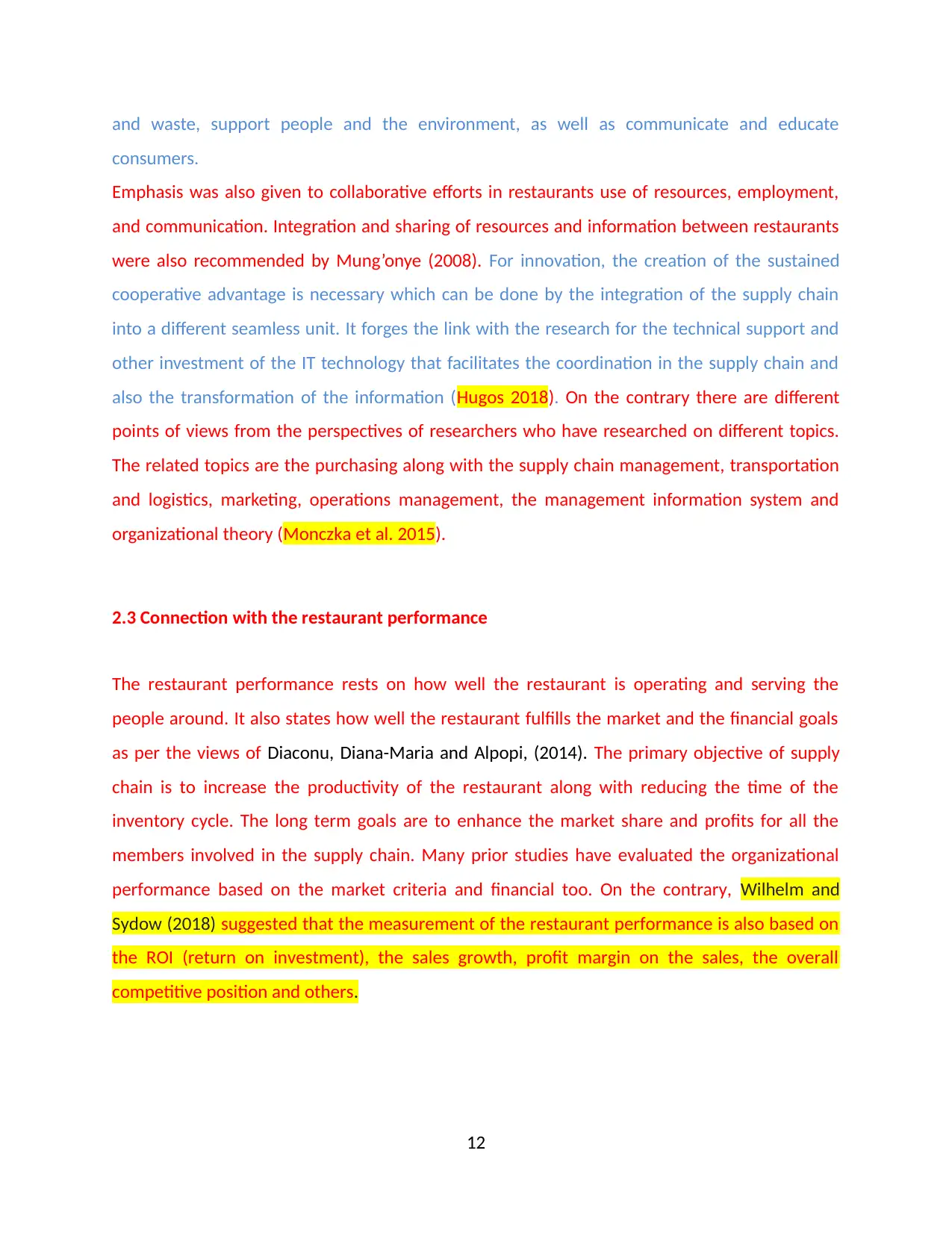
and waste, support people and the environment, as well as communicate and educate
consumers.
Emphasis was also given to collaborative efforts in restaurants use of resources, employment,
and communication. Integration and sharing of resources and information between restaurants
were also recommended by Mung’onye (2008). For innovation, the creation of the sustained
cooperative advantage is necessary which can be done by the integration of the supply chain
into a different seamless unit. It forges the link with the research for the technical support and
other investment of the IT technology that facilitates the coordination in the supply chain and
also the transformation of the information (Hugos 2018). On the contrary there are different
points of views from the perspectives of researchers who have researched on different topics.
The related topics are the purchasing along with the supply chain management, transportation
and logistics, marketing, operations management, the management information system and
organizational theory (Monczka et al. 2015).
2.3 Connection with the restaurant performance
The restaurant performance rests on how well the restaurant is operating and serving the
people around. It also states how well the restaurant fulfills the market and the financial goals
as per the views of Diaconu, Diana-Maria and Alpopi, (2014). The primary objective of supply
chain is to increase the productivity of the restaurant along with reducing the time of the
inventory cycle. The long term goals are to enhance the market share and profits for all the
members involved in the supply chain. Many prior studies have evaluated the organizational
performance based on the market criteria and financial too. On the contrary, Wilhelm and
Sydow (2018) suggested that the measurement of the restaurant performance is also based on
the ROI (return on investment), the sales growth, profit margin on the sales, the overall
competitive position and others.
12
consumers.
Emphasis was also given to collaborative efforts in restaurants use of resources, employment,
and communication. Integration and sharing of resources and information between restaurants
were also recommended by Mung’onye (2008). For innovation, the creation of the sustained
cooperative advantage is necessary which can be done by the integration of the supply chain
into a different seamless unit. It forges the link with the research for the technical support and
other investment of the IT technology that facilitates the coordination in the supply chain and
also the transformation of the information (Hugos 2018). On the contrary there are different
points of views from the perspectives of researchers who have researched on different topics.
The related topics are the purchasing along with the supply chain management, transportation
and logistics, marketing, operations management, the management information system and
organizational theory (Monczka et al. 2015).
2.3 Connection with the restaurant performance
The restaurant performance rests on how well the restaurant is operating and serving the
people around. It also states how well the restaurant fulfills the market and the financial goals
as per the views of Diaconu, Diana-Maria and Alpopi, (2014). The primary objective of supply
chain is to increase the productivity of the restaurant along with reducing the time of the
inventory cycle. The long term goals are to enhance the market share and profits for all the
members involved in the supply chain. Many prior studies have evaluated the organizational
performance based on the market criteria and financial too. On the contrary, Wilhelm and
Sydow (2018) suggested that the measurement of the restaurant performance is also based on
the ROI (return on investment), the sales growth, profit margin on the sales, the overall
competitive position and others.
12
⊘ This is a preview!⊘
Do you want full access?
Subscribe today to unlock all pages.

Trusted by 1+ million students worldwide
1 out of 64
Related Documents
Your All-in-One AI-Powered Toolkit for Academic Success.
+13062052269
info@desklib.com
Available 24*7 on WhatsApp / Email
![[object Object]](/_next/static/media/star-bottom.7253800d.svg)
Unlock your academic potential
Copyright © 2020–2025 A2Z Services. All Rights Reserved. Developed and managed by ZUCOL.




